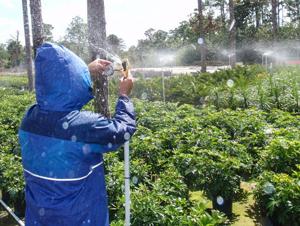Even though Florida is in its rainy season, lasting from May until October, the South Florida Water Management District reports that May and June rainfall totals are well below average across most of South Florida. District weather records show that this period was the driest since 2004 and the ninth driest since recordkeeping began in 1932. Of course, even one tropical disturbance or hurricane could make up at least some of this deficit, if it contains significant rainfall, but this isn’t something to rely on to fix the problem.
So what can we do to help conserve water? One way is to get a free irrigation evaluation from a Mobile Irrigation Lab, and advice on a more efficient irrigation system; saving money and water!
 Outdoor irrigation accounts for up to half of the water used per person, per day. When water is not applied uniformly it is wasted and plants can suffer. Applying too much water can also leach valuable fertilizers and pesticides past the crop root zone, wasting money and potentially harming the water quality.
Outdoor irrigation accounts for up to half of the water used per person, per day. When water is not applied uniformly it is wasted and plants can suffer. Applying too much water can also leach valuable fertilizers and pesticides past the crop root zone, wasting money and potentially harming the water quality.
For more than 16 years, these traveling irrigation labs have been operating throughout Florida. According to the Florida Department of Agriculture and Consumer Services (FDACS) Office of Agricultural Water Policy, 17 mobile irrigation labs provide service in 66 counties. These labs are supported by three of the state’s water management districts, FDACS, the U.S. Department of Agriculture’s Natural Resources Conservation Service (NRCS) and others. Although the labs originally targeted agricultural water use, some also assist residential water users.
Two of these irrigation labs serve the South Florida area. The South Dade Soil and Water Conservation District MIL evaluates irrigation systems in agricultural areas in Miami-DadeCounty. The Palm Beach Soil and Water Conservation District’s lab helps homeowners, municipalities, homeowner associations, businesses and agricultural producers in Palm Beach and BrowardCounties.
When you contact the lab, a trained technician collects information on the irrigation system and specific land and/or field data such as soils, the crop/vegetation being grown, and the type of irrigation system. System pressures and system flow rates, and emitter flow rates are measured and used to determine the overall uniformity and efficiency of the irrigation system. A report provides recommendations for improvements and irrigation schedules. Many of the labs also provide a pump flow test to assist farmers in applying for their Consumptive Water Use permits. These flows are used to determine the amount of water they are pulling from the Biscayne Aquifer and determines the type of permit they will need.
In the case of agricultural evaluations, the local NRCS office can provide technical assistance, and possibly financial assistance, to farmers and ranchers for the design or redesign of the existing irrigation system. Farmers and ranchers might also be eligible for Farm Bill funding to assist with the purchase of a more efficient irrigation system through the NRCS Environmental Quality Incentive Program (EQIP).
Lab technicians are passionate about helping conserve Florida’s water. Leona Yates, Mobile Irrigation Lab technician in St. Lucie County says, “I love Florida and believe water is our most important resource. It is rewarding to know I’m assisting our agricultural community to continue their conservation efforts and that I’m helping secure our future, one drop at a time.”
For more information on mobile irrigation labs go to the FDACS Office of Agriculture Water Policy website. For information on how NRCS can help agricultural producers conserve water in Florida contact your local NRCS office or go to www.fl.nrcs.usda.gov.
Source: http://www.southdadenewsleader.com/news/south-florida-drought-mobile-irrigation-labs-to-the-rescue/article_371e0b18-4042-11e5-b996-97fcce419fcc.html
 0
0
